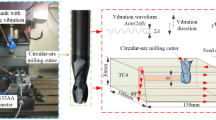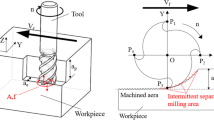Abstract
Ball-end milling cutters are commonly used in the finishing processes of curved-side milling for titanium alloys; however, several issues arise during machining, such as poor cutting conditions at the bottom of the end teeth, low cutting speeds, and limited chip space. Given the above issues, the research on the design and manufacture of conical arc side-edge milling cutter for titanium alloy processing was carried out in this paper; the mathematical model of the vital structure of conical arc side-edge milling cutter was established; the grinding trajectory equations of tool front and flank were deduced; the tool-workpiece kinematics of ultrasonic vibration applied to conical arc side edge was studied; and the comparative experimental study of the conical arc side-edge milling cutter cutting titanium alloy with and without ultrasonic vibration was carried out. The experiment results indicate that in comparison to conventional milling techniques, ultrasonic vibration cutting significantly decreases cutting force, plastic deformation of the chip, and wear rate of the flank face. The tool wear band is both longer and more uniform, bonding phenomena in titanium alloys are distinctly reduced, and tool performance is improved.














Similar content being viewed by others
Data availability
The raw/processed data required to reproduce these findings cannot be shared for the time being. Data will be made available upon request.
References
Wang B, Liu Z (2018) Influences of tool structure, tool material and tool wear on machined surface integrity during turning and milling of titanium and nickel alloys: a review. Int J Adv Manuf Technol 98:1925–1975. https://doi.org/10.1007/s00170-018-2314-1
Williams JC, Boyer RR (2020) Opportunities and issues in the application of titanium alloys for aerospace component. Metals 10(6):705. https://doi.org/10.3390/met10060705
Singh P, Pungotra H, Kalsi NS (2017) On the characteristics of titanium alloys for the aircraft applications. Mater Today: Proc 4(8):8971–8982. https://doi.org/10.1016/j.matpr.2017.07.249
Qingchun X, Ge S, Wei Z (2013) Cutting technology development of titanium alloy aircraft structural part. Aeronaut Manuf Technol 434(014):42–47. https://doi.org/10.16080/j.issn1671-833x.2013.14.013
Niu J, Huang C, Li C et al (2020) A comprehensive method for selecting cutting tool materials. Int J Adv Manuf Technol 110:229–240. https://doi.org/10.1007/s00170-020-05534-0
Zhao J, Liu Z, Wang B et al (2021) Tool coating effects on cutting temperature during metal cutting processes: comprehensive review and future research directions. Mech Syst Signal Process 150(7–8):107302. https://doi.org/10.1016/j.ymssp.2020.107302
Mhamdi MB, Boujelbene M, Bayraktar E et al (2012) Surface integrity of titanium alloy Ti-6Al-4V in ball end milling. Phys Procedia 25:355–362. https://doi.org/10.1016/j.phpro.2012.03.096
Zhao Z, Liu X, Yue C et al (2020) Tool quality life during ball end milling of titanium alloy based on tool wear and surface roughness models. Appl Sci 10(9):3316. https://doi.org/10.3390/app10093316
Mersni W, Boujelbene M, Salem SB et al (2020) Machining time and quadratic mean roughness optimization in ball end milling of titanium alloy Ti-6Al-4V–Aeronautic field. Mater Today: Proc 26:2619–2624. https://doi.org/10.1016/j.matpr.2020.02.553
Chen XF, Ding GF, Li R et al (2014) A new design and grinding algorithm for ball- end milling cutter with tooth offset center. J Eng Manuf 228(7):687–697. https://doi.org/10.1177/0954405413503318
Tao C, Xianli L, Changhong W, Guangyue W (2015) Design and fabrication of double- circular arc torus milling cutter. Int J Adv Manuf Technol 80:567–579. https://doi.org/10.1007/s00170-015-7033-2
Mei J, Luo M, Guo J et al (2018) Analytical modeling, design and performance evaluation of chatter-free milling cutter with alternating pitch variations. IEEE Access 6:32367–32375. https://doi.org/10.1109/ACCESS.2018.2841000
Korovin GI, Petrushin SI, Gubaidulina RH (2018) Machining of titanium alloys with wave milling cutters. MSF 927:79–85.https://doi.org/10.4028/www.scientific.net/msf.927.79
Habibi M, Chen ZC (2017) A generic and efficient approach to determining locations and orientations of complex standard and worn wheels for cutter flute grinding using characteristics of virtual grinding curves. J Manuf Sci Eng 139(4):041018. https://doi.org/10.1115/1.4035421
Nath C, Rahman M (2008) Effect of machining parameters in ultrasonic vibration cutting. Int J Adv Manuf Technol 48(9):965–974. https://doi.org/10.1016/j.ijmachtools.2008.01.01
Zhang X, Sui H, Zhang D et al (2018) An analytical transient cutting force model of high-speed ultrasonic vibration cutting. Int J Adv Manuf Technol 95:3929–3941. https://doi.org/10.1007/s00170-017-1499-z
Sun Z, Geng D, Zheng W, Liu Y, Liu L, Ying E, Jiang X, Zhang D (2023) An innovative study on high-performance milling of carbon fiber reinforced plastic by combining ultrasonic vibration assistance and optimized tool structures. J Mater Res Technol 22:2131–2146. https://doi.org/10.1016/j.jmrt.2022.12.054
Wang M, Li S, Zheng Y (2014) Surface roughness of titanium alloy under ultrasonic vibration milling. Trans Chin Soc Agric Mach 45(6):341–346
Yihang Liu, Deyuan Zhang, Daxi Geng, Zhenyu Shao, Zehua Zhou, Zhefei Sun, Yonggang Jiang, Xinggang Jiang (2023) Ironing effect on surface integrity and fatigue behavior during ultrasonic peening drilling of Ti-6Al-4V. Chin J Aeronaut 36:486–498.https://doi.org/10.1016/j.cja.2022.12.009
Verma GC, Pandey PM, Dixit US (2018) Estimation of workpiece-temperature during ultrasonic-vibration assisted milling considering acoustic softening. Int J mech Sci 140:547–556.https://doi.org/10.1016/j.ijmecsci.2018.03.034
Zhang X, Sui H, Zhang D et al (2017) Feasibility study of high-speed ultrasonic vibration cutting titanium alloy. J Manuf Process 53(19):120–127. https://doi.org/10.1016/j.jmatprotec.2017.03.017
Zhang X, Peng Z, Li Z et al (2020) Influences of machining parameters on tool performance when high-speed ultrasonic vibration cutting titanium alloys. J Manuf Process 60:188–199. https://doi.org/10.1016/j.jmapro.2020.10.053
Nath C, Rahman M, Neo KS (2011) Modeling of the effect of machining parameters on maximum thickness of cut in ultrasonic elliptical vibration cutting. J Manuf Sci Eng 133(1):011007. https://doi.org/10.1115/1.4003118
Liu Y, Geng D, Zhang D, Zhai Y, Liu L, Sun Z, Shao Z, Zhang M, Jiang X (2023) Cutting performance and surface integrity for rotary ultrasonic elliptical milling of Inconel 718 with the ball end milling cutter. J Mater Process Technol 36(5):486–498. https://doi.org/10.1016/j.jmatprotec.2023.118094
Funding
This work was financially supported by the National Natural Science Foundation of China (Grant No. 51475125).
Author information
Authors and Affiliations
Contributions
Guangyue Wang has organized the project, designed the cutting tools, and written the manuscript. Wenyuan Xu has designed the cutting tools and written the manuscript. Chunhui Li participated in the review and proposed amendments. Jiaming Liu has conducted the experiments and collected and analyzed data. Tao Chen has reviewed the manuscript.
Corresponding author
Ethics declarations
Ethical approval
The research does not involve human participants or animals and the authors warrant that the paper fulfills the ethical standards of the journal.
Consent to participate
It is confirmed that all the authors are aware and satisfied of the authorship order and correspondence of the paper.
Consent for publication
All the authors are satisfied that the last revised version of the paper is published without any change.
Competing interests
The authors declare no competing interests.
Additional information
Publisher's Note
Springer Nature remains neutral with regard to jurisdictional claims in published maps and institutional affiliations.
Rights and permissions
Springer Nature or its licensor (e.g. a society or other partner) holds exclusive rights to this article under a publishing agreement with the author(s) or other rightsholder(s); author self-archiving of the accepted manuscript version of this article is solely governed by the terms of such publishing agreement and applicable law.
About this article
Cite this article
Wang, G., Xu, W., Li, C. et al. Study on design of conical arc side-edge milling cutter and cutting performance under ultrasonic-assisted condition. Int J Adv Manuf Technol 132, 1411–1423 (2024). https://doi.org/10.1007/s00170-024-13423-z
Received:
Accepted:
Published:
Issue Date:
DOI: https://doi.org/10.1007/s00170-024-13423-z




